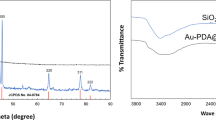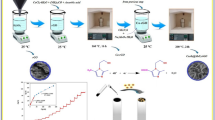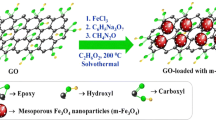Abstract
Azithromycin is one of the most concentrated antibiotics in wastewater, as conventional wastewater treatment facilities cannot eliminate this antibiotic from the environment. In this study, we proposed using a graphene-based mesoporous electrochemical sensor to take simultaneous voltammetric measurements of azithromycin. Because of its homogeneous pore structure, large surface area, quick electron transfer rate, and superior biocompatibility, magnesium-containing mesoporous silica is a promising resource for the immobilization of biomolecule matrix. Ca2+-doped MgAl2O3-G-SiO2 was used to build an amperometric biosensor through a self-assembly process. At room temperature in a buffer solution with a pH of 7.0, the modified electrode under ideal circumstances displayed good azithromycin sensing activity, a linear range of 1 to 5 µmolL−1, a detection limit of 0.5 µmolL−1, and a reaction time of less than 2 sec. An array of morphological analysis methods—including X-ray diffraction methos, scanning electron microscopy, Brunauer-Emmett-Teller method, high resolution tunneling electron microscopy, Raman, diffuse reflectance spectroscopy, and X-ray photoelectron spectroscopy—was used to examine the nanocomposite’s crystalline structure. Cyclic voltammetry was used to determine the sensing effects in the mesoporous active nanomaterials. Finally, it was found that the electrochemical sensor performed as an ideal biosensor that was able to detect azithromycin in the presence of several interfering species with high stability, selectivity, and repeatability.
Similar content being viewed by others
Change history
24 December 2022
An Erratum to this paper has been published: https://doi.org/10.1007/s12257-022-1111-8
References
Sui, Q., X. Cao, S. Lu, W. Zhao, Z. Qiu, and G Yu (2015) Occurrence, sources and fate of pharmaceuticals and personal care products in the groundwater: a review. Emerg. Contam. 1: 14–24.
Ebele, A. J., M. A.-E. Abdallah, and S. Harrad (2017) Pharmaceuticals and personal care products (PPCPs) in the freshwater aquatic environment. Emerg. Contam. 3: 1–16.
Ahmadzadeh, S., A. Asadipour, M. Pournamdari, B. Behnam, H. R. Rahimi, and M. Dolatabadi (2017) Removal of ciprofloxacin from hospital wastewater using electrocoagulation technique by aluminum electrode: optimization and modelling through response surface methodology. Process Saf. Environ. Prot. 109: 538–547.
Diwan, V., N. Hanna, M. Purohit, S. Chandran, E. Riggi, V. Parashar, A. J. Tamhankar, and C. Stålsby Lundborg (2018) Seasonal variations in water-quality, antibiotic residues, resistant bacteria and antibiotic resistance genes of Escherichia coli isolates from water and sediments of the Kshipra River in Central India. Int. J. Environ. Res. Public Health. 15: 1281.
Larsson, D. G. J. (2014) Antibiotics in the environment. Ups. J. Med. Sci. 119: 108–112.
Grenni, P., V. Ancona, and A. B. Caracciolo (2018) Ecological effects of antibiotics on natural ecosystems: a review. Microchem. J. 136: 25–39.
Chavada, V. D., N. M. Bhatt, M. Sanyal, and P. S. Shrivastav (2018) Simultaneous determination of azithromycin and levooxacin in pharmaceuticalsby charge transfer complexation with alizarin red S using an absorption-factor method. Turk. J. Chem. 42: 36–49.
Han, R. W., N. Zheng, Z. N. Yu, J. Wang, X. M. Xu, X. Y. Qu, S. L. Li, Y. D. Zhang, and J. Q. Wang (2015) Simultaneous determination of 38 veterinary antibiotic residues in raw milk by UPLC-MS/MS. Food Chem. 181: 119–126.
Hu, L., T. Zhou, J. Feng, H. Jin, Y. Tao, D. Luo, S. Mei, and Y.-I. Lee (2018) A rapid and sensitive molecularly imprinted electrochemiluminescence sensor for Azithromycin determination in biological samples. J. Electroanal. Chem. (Lausanne) 813: 1–8.
Golovko, O., S. Örn, M. Sörengård, K. Frieberg, W. Nassazzi, F. Y. Lai, and L. Ahrens (2021) Occurrence and removal of chemicals of emerging concern in wastewater treatment plants and their impact on receiving water systems. Sci. Total Environ. 754: 142122.
Fatema, K. N., M. R. U. D. Biswas, S. H. Bang, K. Y. Cho, and W.-C. Oh (2020) Electroanalytical characteristic of a novel biosensor designed with graphene–polymer-based quaternary and mesoporous nanomaterials. Bull. Mater. Sci. 43: 121.
Fatema, K. N., Y. Liu, K. Y. Cho, and W. C. Oh (2020) Comparative study of electrochemical biosensors based on highly efficient mesoporous ZrO2-Ag-G-SiO2 and In2O3-G-SiO2 for rapid recognition of E. coliO157:H7. ACS Omega. 5: 22719–22730.
Fatema, K. N., L. Zhu, K. Y. Cho, C.-H. Jung, K. Ullah, and W.-C. Oh (2021) Non-enzymatic sensing of glucose with high specificity and sensitivity based on high surface area mesoporous BiZnSbV-G-SiO2. J. Mater. Sci. Mater. Electron. 32: 8330–8346.
Jafari, S., N. Nasirizadeh, and M. Dehghani (2017) Developing a highly sensitive electrochemical sensor using thiourea-imprinted polymers based on an MWCNT modified carbon ceramic electrode. J. Electroanal. Chem. (Lausanne) 802: 139–146.
Fatema, K. N. and W. C. Oh (2021) A comparative electrochemical study of non-enzymatic glucose, ascorbic acid, and albumin detection by using a ternary mesoporous metal oxide (ZrO2, SiO2 and In2O3) modified graphene composite based biosensor. RSC Adv. 11: 4256–4269.
Fatema, K. N., S. Sagadevan, Y. Liu, K. Y. Cho, C.-H. Jung, and W.-C. Oh (2020) New design of mesoporous SiO2 combined In2O3-graphene semiconductor nanocomposite for highly effective and selective gas detection. J. Mater. Sci. 55: 13085–13101.
Fatema, K. N., C. H. Jung, Y. Liu, S. Sagadevan, K. Y. Cho, and W. C. Oh (2020) New design of active material based on YInWO4-G-SiO2 for a urea sensor and high performance for nonenzymatic electrical sensitivity. ACS Biomater. Sci. Eng. 6: 6981–6994.
Fatema, K. N., C. S. Lim, and W.-C. Oh (2021) High surface area mesoporous BiZnSbV-G-SiO2-based electrochemical biosensor for quantitative and rapid detection of microalbuminuria. J. Appl. Electrochem. 51: 1345–1360.
Arayne, S., N. Sultana, S. Shamim, and A. Naz (2014) Synthesis characterization and antimicrobial activities of azithromycin metal complexes. Mod. Chem. Appl. 2: 133.
Oh, W.-C., K. N. Fatema, Y. Liu, K. Y. Cho, K. L. Ameta, S. Chanthai, and M. R. U. D. Biswas (2021) Chemo-electrical gas sensors based on LaNiMoSe2 in graphene and conducting polymer PANI composite semiconductor nanocomposite. J. Electron. Mater. 50: 5754–5764.
Oh, W.-C., C. S. Lim, Y. Liu, S. Sagadevan, W. K. Jang, and M. R. U. D. Biswas (2021) Quaternary nanorod-type BaInSbSe5 semiconductor combined graphene-based conducting polymer (PPy) nanocomposite and highly sensing performance of H2O2 & H2S gases. J. Mater. Sci. Mater. Electron. 32: 15944–15963.
Zhang, K., L. Lu, Y. Wen, J. Xu, X. Duan, L. Zhang, D. Hu, and T. Nie (2013) Facile synthesis of the necklace-like graphene oxide-multi-walled carbon nanotube nanohybrid and its application in electrochemical sensing of azithromycin. Anal. Chim. Acta. 787: 50–56.
Oh, W.-C., K. N. Fatema, Y. Liu, K. Y. Cho, C. H. Jung, and M. R. U. D. Biswas (2021) Novel designed quaternary CuZnSnSe semiconductor combined graphene-polymer (CuZnSnSe-G-PPy) composites for highly selective gas-sensing properties. J. Mater. Sci. Mater. Electron. 32: 12812–12821.
Oh, W.-C., Y. Liu, S. Sagadevan, K. N. Fatema, and M. R. U. D. Biswas (2021) Polymer bonded Graphene- LaNiSbWO4 nanocomposite (G-LaNiSbWO4-PPy) for CO2 sensing performance under normal temperature condition. Inorg. Nano-Met. Chem. 51: 1803–1812.
Vasuki, S., V. Varsha, Mithra, R. A. Dharshni, S. Abinaya, R. D. Dharshini, and N. Sivarajasekar (2019) Thermal biosensors and their applications. Am. Int. J. Res. Sci. Technol. Eng. Math. 262–264.
Chen, T.-W., U. Rajaji, S.-M. Chen, A. Muthumariyappan, M. M. A. Mogren, R. Jothi Ramalingam, and M. Hochlaf (2019) Facile synthesis of copper(II) oxide nanospheres covered on functionalized multiwalled carbon nanotubes modified electrode as rapid electrochemical sensing platform for super-sensitive detection of antibiotic. Ultrason. Sonochem. 58: 104596.
Author information
Authors and Affiliations
Corresponding author
Ethics declarations
The authors declare no conflict of interest.
Neither ethical approval nor informed consent was required for this study.
Additional information
Publisher’s Note Springer Nature remains neutral with regard to jurisdictional claims in published maps and institutional affiliations.
Electronic supplementary material
Rights and permissions
About this article
Cite this article
Cho, K.Y., Jung, CH. & Oh, WC. Novel Synthesis of Ca2+-Doped MgAl2O3-G-SiO2 Mesoporous Nanospheres toward Sensing Effects for Selective Electrochemical Performance of Azithromycin. Biotechnol Bioproc E 27, 857–868 (2022). https://doi.org/10.1007/s12257-022-0071-3
Received:
Revised:
Accepted:
Published:
Issue Date:
DOI: https://doi.org/10.1007/s12257-022-0071-3




